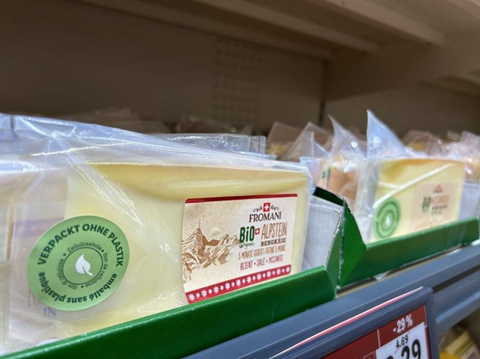
In collaboration with Swiss cheese company Hardegger Käse, Lidl Switzerland has introduced cellulose-based packaging made from leftover wood for several organic cheeses.
Apparently, the new cellulose-based packaging is used for organic Alpstein mountain cheese and organic Usserrhödler mountain cheese. The cellulose film is said to be free of crude oil-based raw materials and is made from leftover wood from FSC-certified forestry.
The packaging aims to preserve taste and guarantee product safety. The new solution has currently been introduced in over 100 stores and is mainly available in German-speaking Switzerland and Ticino.
As part of its sustainability strategy, Lidl Switzerland says it is pursuing the goal of reducing the use of plastic in its own-brand products by 30% by 2025. It adds that by the end of 2025, all its own-brand packaging should be designed to be as recyclable as possible and contain at least 25% recycled material on average.
Reportedly, at the end of 2023, the average proportion of recycled material in Lidl’s own-brand packaging was over 25%, meaning the goal was achieved two years early. Lidl Switzerland states a significant milestone was the conversion of the 1.5 litre bottles of its own brand Saguaro with Swiss water to 100% recycled PET in 2022. The retailer claims it saves around 157 tonnes of new plastic per year with this measure.
“We are pleased to offer a sustainable packaging solution with Lidl Switzerland,” says Sandro Renz, head of Sales and Marketing at Hardegger Käse AG. “Our cellulose-based film offers identical properties in terms of durability and quality as conventional plastic films.”
In February this year, we heard from experts at Stora Enso Packaging Materials in an episode of our Packaging Europe podcast series about microfibrillated cellulose (MFC) as an innovation that enables lightweight paperboard. Kati Ekman, Tuomas Puonti and Mateo Saavedra del Oso spoke to our editor at large, Elisabeth Skoda, about MFC, its role in lightweighting and how it supports the efficient use of fibres.
More recently, researchers at The University of Maine are hoping to streamline the commercial adoption of cellulose nanofibers as a packaging material by developing an electrostatic contact dewatering technique, thus speeding up the drying process. The technique is thought to reduce drying time by five times and improve the cost efficiency of cellulose nanofiber films.
If you liked this story, you might also enjoy:
How are the top brands progressing on packaging sustainability?
Sustainable Innovation Report 2024: Current trends and future priorities
Reuse vs. single use – which is better for the environment?
The ultimate guide to global plastic sustainability regulation


















No comments yet